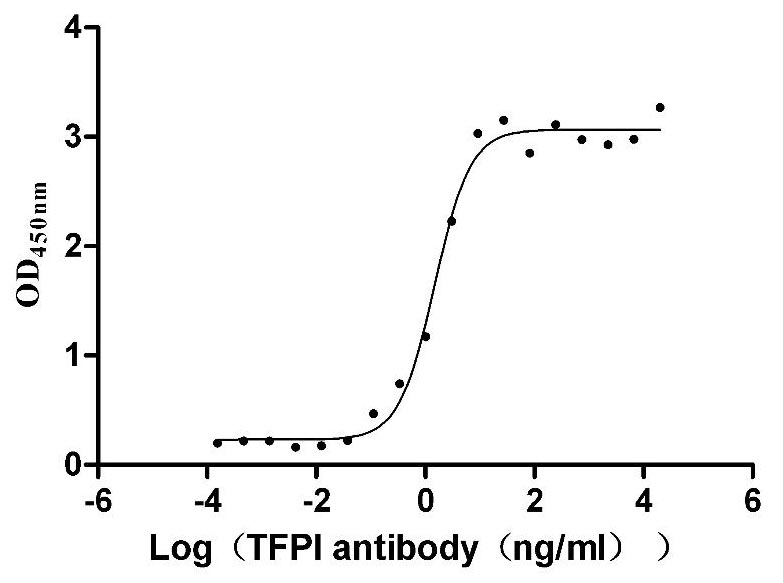Recombinant WU polyomavirus Minor capsid protein VP2
-
中文名稱:Recombinant WU polyomavirus Minor capsid protein VP2,Yeast
-
貨號(hào):CSB-YP400167WBG
-
規(guī)格:
-
來源:Yeast
-
其他:
-
中文名稱:Recombinant WU polyomavirus Minor capsid protein VP2,Yeast
-
貨號(hào):CSB-EP400167WBG
-
規(guī)格:
-
來源:E.coli
-
其他:
-
中文名稱:Recombinant WU polyomavirus Minor capsid protein VP2,Yeast
-
貨號(hào):CSB-EP400167WBG-B
-
規(guī)格:
-
來源:E.coli
-
共軛:Avi-tag Biotinylated
E. coli biotin ligase (BirA) is highly specific in covalently attaching biotin to the 15 amino acid AviTag peptide. This recombinant protein was biotinylated in vivo by AviTag-BirA technology, which method is BriA catalyzes amide linkage between the biotin and the specific lysine of the AviTag.
-
其他:
-
中文名稱:Recombinant WU polyomavirus Minor capsid protein VP2,Yeast
-
貨號(hào):CSB-BP400167WBG
-
規(guī)格:
-
來源:Baculovirus
-
其他:
-
中文名稱:Recombinant WU polyomavirus Minor capsid protein VP2,Yeast
-
貨號(hào):CSB-MP400167WBG
-
規(guī)格:
-
來源:Mammalian cell
-
其他:
產(chǎn)品詳情
-
純度:>85% (SDS-PAGE)
-
基因名:N/A
-
Uniprot No.:
-
別名:; Minor capsid protein VP2; Minor structural protein VP2
-
種屬:WU polyomavirus (WUPyV)
-
蛋白長(zhǎng)度:Full Length of Mature Protein
-
表達(dá)區(qū)域:2-415
-
氨基酸序列GILLAVPEI IAASVAGGAE ALSIAGSGAA IATGEGLAAL GGLTESAALL GETVEISEAA ATVLTKVPEL VTVTQGVTAA VQGGAGLVGG IYTALAADRP GDLPASTPTG SPSGLHPPAG YNPQGGGLNI QSIHKPLHAP YPGMALAPIP EYNLETGIPG VPDWVFNFIA SHLPELPSLQ DVFNRIAYGI WTSYYNTGRT VVNRAVSEEL QRLLGDLEYG FRTALATIGE SDPVNAIVEQ VRSFVSGGRQ RELLQIAAGQ PVDISEGVSR GTATISNAVE AVRDATQRLS QATYNFVYDA STLPRDGFNA LSDGVHRLGQ WISMPGATGG TPHYAAPDWI LYVLEELNSD ISKIPTQGIK RKLQQNGLHS KASLHSKTRK VTKKSTHKSA KPSKTSQKRR GRRAGRRTTV RRNRV
-
蛋白標(biāo)簽:Tag?type?will?be?determined?during?the?manufacturing?process.
The tag type will be determined during production process. If you have specified tag type, please tell us and we will develop the specified tag preferentially. -
產(chǎn)品提供形式:Lyophilized powder
Note: We will preferentially ship the format that we have in stock, however, if you have any special requirement for the format, please remark your requirement when placing the order, we will prepare according to your demand. -
復(fù)溶:We recommend that this vial be briefly centrifuged prior to opening to bring the contents to the bottom. Please reconstitute protein in deionized sterile water to a concentration of 0.1-1.0 mg/mL.We recommend to add 5-50% of glycerol (final concentration) and aliquot for long-term storage at -20℃/-80℃. Our default final concentration of glycerol is 50%. Customers could use it as reference.
-
儲(chǔ)存條件:Store at -20°C/-80°C upon receipt, aliquoting is necessary for mutiple use. Avoid repeated freeze-thaw cycles.
-
保質(zhì)期:The shelf life is related to many factors, storage state, buffer ingredients, storage temperature and the stability of the protein itself.
Generally, the shelf life of liquid form is 6 months at -20°C/-80°C. The shelf life of lyophilized form is 12 months at -20°C/-80°C. -
貨期:Delivery time may differ from different purchasing way or location, please kindly consult your local distributors for specific delivery time.Note: All of our proteins are default shipped with normal blue ice packs, if you request to ship with dry ice, please communicate with us in advance and extra fees will be charged.
-
注意事項(xiàng):Repeated freezing and thawing is not recommended. Store working aliquots at 4°C for up to one week.
-
Datasheet :Please contact us to get it.
靶點(diǎn)詳情
-
功能:Isoform VP2 is a structural protein that resides within the core of the capsid surrounded by 72 VP1 pentamers. Participates in host cell receptor binding together with VP1. Following virus endocytosis and trafficking to the endoplasmic reticulum, VP2 and VP3 form oligomers and integrate into the endoplasmic reticulum membrane. Heterooligomer VP2-VP3 may create a viroporin for transporting the viral genome across the endoplasmic reticulum membrane to the cytoplasm. Nuclear entry of the viral DNA involves the selective exposure and importin recognition of VP2 or Vp3 nuclear localization signal (shared C-terminus). Plays a role in virion assembly within the nucleus in particular through a DNA-binding domain located in the C-terminal region. A N-terminal myristoylation suggests a scaffold function for virion assembly.; structural protein that resides within the core of the capsid surrounded by 72 VP1 pentamers. Following virus endocytosis and trafficking to the endoplasmic reticulum, VP2 and VP3 form oligomers and integrate into the endoplasmic reticulum membrane. Heterooligomer VP2-VP3 may create a viroporin for transporting the viral genome across the endoplasmic reticulum membrane to the cytoplasm. Nuclear entry of the viral DNA involves the selective exposure and importin recognition of VP2 or Vp3 nuclear localization signal (shared C-terminus). Isoform VP3 plays a role in virion assembly within the nucleus.
-
亞細(xì)胞定位:[Isoform VP2]: Virion. Host nucleus. Host endoplasmic reticulum. Host endoplasmic reticulum membrane.; [Isoform VP3]: Virion. Host nucleus. Host endoplasmic reticulum. Host endoplasmic reticulum membrane.
-
蛋白家族:Polyomaviruses capsid protein VP2 family
-
數(shù)據(jù)庫(kù)鏈接:
KEGG: vg:5309724
Most popular with customers
-
Recombinant Macaca fascicularis Angiotensin-converting enzyme (ACE2), partial (Active)
Express system: Mammalian cell
Species: Macaca fascicularis (Crab-eating macaque) (Cynomolgus monkey)
-
Recombinant Paguma larvata Angiotensin-converting enzyme 2 (ACE2), partial (Active)
Express system: Mammalian cell
Species: Paguma larvata (Masked palm civet)
-
Recombinant Human Cytokine receptor common subunit beta (CSF2RB), partial (Active)
Express system: Mammalian cell
Species: Homo sapiens (Human)
-
Recombinant Human Tissue factor pathway inhibitor (TFPI), partial (Active)
Express system: Mammalian cell
Species: Homo sapiens (Human)
-
Recombinant Human Claudin-4 (CLDN4)-VLPs (Active)
Express system: Mammalian cell
Species: Homo sapiens (Human)
-
Recombinant Human Desmoglein-2 (DSG2), partial (Active)
Express system: Mammalian cell
Species: Homo sapiens (Human)
-
-
Recombinant Human Kidney-associated antigen 1(KAAG1) (Active)
Express system: E.coli
Species: Homo sapiens (Human)


















